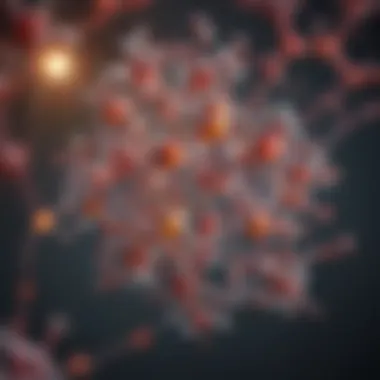Understanding NAD and NADH in Cellular Metabolism


Intro
Nicotinamide adenine dinucleotide (NAD) and its reduced form, NADH, are crucial coenzymes in cellular metabolism. They participate in various biological processes, significantly affecting energy production and metabolic pathways. A proper understanding of NAD and NADH is essential for delving into how our cells function and how they respond to different physiological states.
In this discussion, we will explore the roles of NAD and NADH in metabolic processes, their impact on health, and their potential therapeutic applications. This exploration will illuminate the biochemical underpinnings of energy production in cells, emphasizing the importance of these compounds in various physiological contexts.
Research Overview
Summary of Key Findings
Research indicates that NAD plays a central role in redox reactions, wherein it facilitates the transfer of electrons during metabolic processes. NAD functions as an electron carrier, accepting electrons to form NADH, which is then used in the production of ATP during cellular respiration. This cycle is fundamental to cellular energy production. Moreover, NAD also assists in the regulation of several metabolic pathways, including those involved in DNA repair and stress responses.
Additionally, current studies suggest that a decline in NAD levels may be linked to age-related diseases, metabolic disorders, and other health complications. These findings underscore the necessity of maintaining optimal NAD levels for overall health.
Relevance to Current Scientific Discussions
The importance of NAD and NADH extends beyond basic metabolic functions. Discussions in scientific circles often focus on the implications of NAD in aging and disease. As research progresses, the potential for therapeutic interventions aimed at modulating NAD levels gains traction. Various studies are investigating the impact of NAD precursors, such as nicotinamide riboside, in enhancing NAD biosynthesis and their subsequent effects on health.
"Understanding NAD and NADH not only enhances our grasp of cellular metabolism but also opens avenues for novel therapeutic strategies in diseases linked to metabolic dysfunction."
Methodology
Research Design and Approach
Studies examining the roles of NAD and NADH often utilize a combination of molecular biology techniques and metabolic profiling. Researchers design experiments to assess the biochemical pathways involving these coenzymes. Utilizing both in vitro and in vivo models allows for a comprehensive understanding of NAD’s involvement in cellular processes.
Data Collection and Analysis Techniques
Data is collected through various techniques, including spectrometry and chromatography, to measure the levels of NAD and NADH in different cell types and conditions. Enzymatic assays are frequently used to evaluate redox activity. Statistical analyses help in interpreting the results, establishing correlations between NAD levels and various health outcomes.
The ongoing research continues to reveal the multifaceted roles of these biomolecules, which hold the potential to influence not just metabolic health but also broader aspects of human longevity and disease prevention.
Foreword to NAD and NADH
NAD and NADH are essential components in the intricate web of cellular metabolism. Their functions extend beyond mere involvement in biochemical reactions; they play critical roles in energy production, metabolic regulation, and cell signaling. Understanding these molecules provides valuable insight into how cells generate energy and maintain homeostasis. This explanation helps to illuminate their importance in biochemical pathways, aging, disease processes, and therapeutic advancements.
Definition and Importance
NAD, or nicotinamide adenine dinucleotide, is a coenzyme found in all living cells. It exists in two forms: the oxidized form NAD+ and the reduced form NADH. The interconversion between these two states is central to metabolic processes. NAD+ acts as an electron carrier during cellular respiration and plays a pivotal role in energy production via processes such as glycolysis and the citric acid cycle. Moreover, NADH is a key player in conveying energy to the electron transport chain, where significant ATP synthesis occurs.
The importance of NAD and NADH also lies in their capacity to influence various cellular processes. For instance, they are involved in redox reactions, where they facilitate the transfer of electrons. This property makes them indispensable in maintaining the balance of oxidative stress within cells. By reducing or oxidizing other molecules, NAD and NADH assist in preserving cellular integrity and function.
In addition, their roles extend into the realm of signaling pathways, highlighting their contributions to cellular communication. Enhanced awareness of NAD and NADH can aid in the understanding of how energy metabolism affects health and longevity.
Chemical Structure
The chemical structure of NAD is composed of two nucleotides joined by their phosphate groups. One nucleotide contains an adenine base, while the other includes nicotinamide. The formation of NAD involves a glycosidic bond connecting the ribose of the adenine nucleotide to the nicotinamide moiety. This architecture allows NAD to engage effectively in redox reactions, where it can either accept or donate electrons to other compounds.
In its oxidized form (NAD+), it serves as an electron acceptor, gaining a hydride ion to become NADH, which acts as a reducing agent in various reactions. The dynamic conversion between these two forms is facilitated by specific enzymes, including dehydrogenases. This biochemical interchange enables cells to adapt metabolism based on energy needs and substrate availability.
In summary, understanding the fundamental structure and role of NAD and NADH provides a foundational comprehension of cellular metabolism and its broader implications in health and disease.
Biochemical Functions of NAD and NADH
NAD and NADH play critical roles in cellular metabolism. Their biochemical functions are fundamental to various metabolic pathways and processes that maintain cellular health. Understanding these functions provides insights into how cells generate energy, manage oxidative stress, and respond to environmental signals. In this section, we will explore the role of NAD and NADH in metabolic pathways, their function as coenzymes, and their contributions to energy production.
Role in Metabolic Pathways


NAD acts as a pivotal electron carrier in metabolic pathways. It plays a crucial role in both catabolic and anabolic reactions.
- Catabolism: In cellular respiration, NAD is involved in breaking down glucose and fatty acids, facilitating energy production. For instance, during glycolysis, NAD picks up electrons when glucose is oxidized. This process continues in the citric acid cycle, where NADH is generated and carried to the electron transport chain.
- Anabolism: NAD also participates in biosynthetic pathways. For example, it supports the synthesis of cholesterol and fatty acids. Here, it provides the necessary reducing power by donating electrons to various biochemical reactions.
NAD as a Coenzyme
NAD functions as a coenzyme for numerous enzymes. It assists in catalyzing oxidation-reduction reactions.
- Key Enzymes: Most notably, dehydrogenases rely on NAD to transfer electrons. Enzymes like lactate dehydrogenase and pyruvate dehydrogenase are examples of such vital enzymes. These enzymes facilitate important processes that⏤
- Metabolic Efficiency: The role of NAD as a coenzyme enhances the efficiency of metabolic pathways. By promoting electron transfer, it increases the speed and effectiveness of metabolic reactions.
- Convert pyruvate to lactate in anaerobic metabolism.
- Enable the conversion of pyruvate to Acetyl-CoA in aerobic conditions.
NADH in Energy Production
NADH is integral to energy production in cells. Its primary importance arises in the context of the electron transport chain.
- Electron Transport Chain (ETC): In mitochondria, NADH donates electrons to the ETC, which is fundamental for ATP synthesis.
- Shuttling Electrons: NADH can also cross the mitochondrial membrane through specific shuttle systems, such as the malate-aspartate shuttle and glycerol phosphate shuttle.
- As NADH is oxidized back to NAD, the released electrons travel through protein complexes in the mitochondrial inner membrane.
- This process creates a proton gradient that drives ATP synthase to produce ATP.
- These systems ensure efficient transfer of electrons from the cytosol into the mitochondria for maximal ATP yield.
In summary, the biochemical functions of NAD and NADH are essential for maintaining cellular metabolism. Their roles in metabolic pathways, enzymatic activities, and energy production illustrate their significance. Understanding these functions allows researchers and healthcare professionals to evaluate metabolic health and address potential disorders.
"NAD and NADH serve as vital players in energy metabolism, acting as conduits for electron transport and energy transfer in cellular processes."
By exploring their biochemical functions, one can grasp the importance of these molecules in sustaining life's energy demands.
NAD/NADH Interconversion
The interconversion between NAD and NADH plays a crucial role in cellular metabolism. This process is essential for maintaining energy balance and supporting various metabolic pathways. Understanding how NAD and NADH are converted is important for both physiological function and potential therapeutic interventions.
In simple terms, NAD (Nicotinamide adenine dinucleotide) acts as an oxidizing agent. It helps in the reaction where it accepts electrons, thus reducing to NADH. Conversely, NADH can donate these electrons, oxidizing back to NAD. This cycle is vital in cellular respiration and energy production, primarily through the mitochondria.
Redox Reactions
Redox reactions, short for reduction-oxidation reactions, involve the transfer of electrons from one molecule to another. In the context of NAD and NADH, these reactions are fundamental.
- NAD as Oxidizing Agent: When NAD accepts electrons, it undergoes reduction to form NADH. This process is essential in glycolysis and the citric acid cycle, where various substrates are oxidized to produce energy.
- NADH as Reducing Agent: In turn, NADH can be oxidized back to NAD. This occurs during the electron transport chain, contributing to ATP synthesis, which is the energy currency of the cell.
Through these redox reactions, cells can efficiently manage energy flow. Any disruption in this balance can lead to metabolic disorders or contribute to disease states.
Enzymatic Regulation
The enzymatic regulation of NAD/NADH interconversion is critical for cellular health. Certain enzymes facilitate the conversion of NAD to NADH and vice versa. These include:
- Dehydrogenases: These enzymes catalyze the oxidation of substrates, transferring electrons to NAD, thus producing NADH.
- NADH Dehydrogenases: They promote the opposite reaction, oxidizing NADH back to NAD.
The activity of these enzymes can be influenced by several factors, such as substrate availability, product inhibition, and the overall energy state of the cell. It’s also worth noting that the ratio of NAD to NADH can influence cellular signaling pathways.
"The balance of NAD and NADH is not just a metabolic feature; it is a central pillar of cellular signaling and energy management."
NAD and Cellular Signaling
NAD plays a crucial role beyond its well-established functions in metabolic pathways. The signaling properties of NAD and its derivatives create a complex network of cellular communication. These aspects are vital for maintaining homeostasis, modulating metabolic responses, and influencing various physiological processes. Understanding NAD-dependent signaling mechanisms is essential for appreciating how cells adapt to metabolic challenges and environmental changes.
NAD+ as a Signaling Molecule


NAD+ functions as a signaling molecule involved in a multitude of cellular processes. It acts as a substrate for enzymes that play key roles in cell signaling. For example, NAD+ is involved in the activation of sirtuins, a family of proteins that regulate cellular stress responses, metabolism, and lifespan. Sirtuins depend on NAD+ levels to exert their effects on various targets, including transcription factors and metabolic enzymes.
NAD+ also plays a part in the synthesis of cyclic ADP-ribose, a second messenger involved in calcium signaling in cells. This signaling pathway is vital for numerous physiological responses. Increased levels of NAD+ signal the need for enhanced calcium release from stores, which can stimulate various downstream signaling pathways, influencing cell survival and function.
Due to its role in cellular signaling, NAD+ levels can significantly affect physiological health and disease states.
NAD-Dependent Reactions
NAD-dependent reactions facilitate key biological processes. Enzymes that rely on NAD+ are involved in redox reactions, where they alternate between oxidized and reduced forms. This conversion is critical for maintaining the cellular balance of redox states, which is integral to cellular metabolism.
Moreover, NAD+ influences various NAD+-dependent reactions such as ADP-ribosylation, a process that modifies proteins to alter their function and activity. This modification is important for the regulation of cell signaling pathways, impacting metabolism, gene expression, and even DNA repair.
Key enzyme classes that utilize NAD+ include:
- Dehydrogenases: Involved in energy production through glycolysis and the citric acid cycle.
- Poly(ADP-ribose) polymerases (PARPs): Engage in DNA repair and modulate gene expression by adding ADP-ribose units to target proteins.
The interplay of NAD+ in these reactions signifies its part in both metabolic energy processes and critical signaling pathways.
The regulation of NAD+ levels is not merely a metabolic concern; it is central to the modulation of signaling pathways that dictate cellular responses to stress, nutrient availability, and other environmental factors.
NAD and Aging
NAD and NADH play significant roles in the aging process. Understanding these compounds is key in unraveling the biological mechanics of longevity and age-related diseases. The balance of NAD levels influences various metabolic pathways that are crucial for maintaining cellular health. As a central player in energy metabolism and redox status, NAD can impact the rate of aging and the onset of age-associated conditions.
Impact on Longevity
Research indicates that higher levels of NAD+ correlate with improved metabolic functions, potentially leading to enhanced longevity. Studies suggest that boosting NAD+ levels can support the activity of proteins crucial for DNA repair, stress response, and cellular energy production. These proteins include sirtuins, which have been linked to the regulation of lifespan in various organisms.
Regularly replenishing NAD levels may help counteract age-related declines in cellular functions. It is thought that facilitating NAD synthesis and availability could enhance mitochondrial function, ultimately supporting healthier aging. Some studies suggest that the addition of precursors like nicotinamide riboside or nicotinamide mononucleotide could elevate NAD levels and improve metabolic health, which could be beneficial in the context of longevity.
NAD Decline with Age
The decline of NAD levels with age has been observed consistently across multiple studies. This decrease contributes to mitochondrial dysfunction and diminished energy metabolism. As NAD+ levels drop, the efficiency of cellular respiration may decrease, leading to a cascade of negative effects on cellular processes.
This decline impacts various biological systems:
- Metabolic Dysregulation: Lower NAD+ availability can lead to impaired glucose metabolism and dysregulated lipid profiles.
- Increased Oxidative Stress: A decrease in NAD+ can reduce the capacity for redox reactions, elevating oxidative stress levels in cells.
- Impaired DNA Repair Mechanisms: With reduced NAD+, the activity of sirtuins and other NAD+-dependent enzymes that facilitate DNA repair can diminish, increasing the risk of genomic instability.
Understanding the correlation between NAD decline and aging is crucial for developing therapies. Strategies focused on restoring NAD levels have the potential to mitigate many age-associated disorders, making it a significant area for future research.
NAD and Disease
NAD and its reduced form NADH are not merely byproducts of cellular metabolism; they play critical roles in various disease contexts. Understanding their functions can provide insight into potential therapeutic approaches for many conditions. Research has increasingly focused on how shifts in NAD and NADH levels relate to disease, particularly in areas such as neurological, metabolic, and oncological disorders. By probing into these connections, scientists hope to unlock new strategies for treatment and prevention.
Neurological Disorders
NAD’s role in neurological health is particularly poignant. Several studies suggest a direct link between NAD levels and neurodegenerative diseases. For example, diseases like Alzheimer's and Parkinson's exhibit altered NAD metabolism. Low NAD levels hinder cellular energy production in neurons, potentially leading to cell death. In fact, supplementing NAD precursors has shown promise in preclinical models.
- Decreased NAD levels correlate with increased oxidative stress.
- NAD precursors such as nicotinamide riboside have been studied for their neuroprotective properties.
- Therapeutic possibilities include enhancing NAD synthesis to improve cognitive function in affected individuals.
The implications are significant. By boosting NAD levels, we may mitigate the effects of neurodegeneration, providing a protective effect that could slow disease progression.
Metabolic Disorders
NAD is crucial in metabolic pathways, influencing conditions such as obesity and diabetes. Altered NAD metabolism can contribute to insulin resistance and lipid accumulation. Research indicates that NAD+ modulates key metabolic enzymes that regulate glucose and lipid homeostasis. Restoration of NAD levels can enhance metabolic flexibility and improve insulin sensitivity.
- Key pathways affected include glycolysis and the Krebs cycle, where NAD plays a pivotal role in energy production.
- Studies show that NAD+ depletion diminishes mitochondrial function, which is often seen in metabolic disorders.
- Potential interventions leverage NAD boosters as a way to rejuvenate metabolic pathways disrupted by disease.


By targeting NAD levels, it may be possible to develop new therapies for managing metabolic diseases, thus improving quality of life for many individuals.
Cancer Metabolism
Cancer cells display altered metabolic profiles, often referred to as the Warburg effect, where they rely on anaerobic glycolysis for energy even in the presence of oxygen. NAD and NADH are intricately involved in these processes. Tumor cells often have increased NAD+ levels to support their high metabolic demands. Understanding this could open doors to novel metabolic therapies.
- NAD+ is essential for the activity of enzymes like poly(ADP-ribose) polymerases (PARPs), which repair DNA but also may contribute to cancer cell survival.
- Inhibition of NAD+ synthesis has been explored as a potential therapeutic strategy. It can lead to impaired DNA repair mechanisms in cancer cells.
- Recent findings suggest that disrupting the balance of NAD/NADH may selectively target cancer cells without harming normal cells.
Research continues to shed light on how modulating NAD levels can be transformed into a therapeutic tool against cancer, reinforcing the need for ongoing investigation in this area.
"Understanding NAD metabolism offers a pathway to novel therapeutic avenues in complex diseases such as cancer and neurological disorders."
Experimental Models of NAD/NADH Bioavailability
In understanding the roles of NAD and NADH in cellular metabolism, it is crucial to examine the experimental models that reveal their bioavailability. These models illuminate how these compounds behave within biological systems, providing insights into their function and potential therapeutic applications. Through strategic study designs, researchers can determine how NAD and NADH concentrations fluctuate under various physiological and pathological conditions. Such knowledge is vital for developing treatments targeting metabolic disorders, age-related decline, and more.
Animal Studies
Animal studies serve as a powerful method to evaluate NAD and NADH bioavailability. In these experiments, various animal models can be utilized, ranging from rodents to larger mammals. These models allow researchers to manipulate dietary factors, genetic outcomes, and environmental influences on NAD and NADH levels. Evidence from such studies can illustrate how supplementation affects metabolic pathways and overall health.
- Dietary Influence: Different diets can significantly alter NAD and NADH concentrations. For instance, a high-protein diet can boost NADH levels, enhancing energy production in muscle cells.
- Pharmacological Interventions: Various compounds, like nicotinamide riboside, have been shown to elevate NAD levels in animal models, demonstrating potential therapeutic pathways.
- Disease Models: Utilizing models of specific diseases, like diabetes or neurodegenerative disorders, reveals the role of NAD and NADH in pathophysiology and aids in testing treatment efficacy.
"Animal models provide essential insight into metabolic processes, shedding light on the impact of NAD and NADH on health and disease."
Cell Culture Studies
Cell culture studies complement animal research by offering a controlled environment to examine NAD and NADH dynamics at the cellular level. These studies allow manipulation of various factors, like nutrient availability and oxygen levels, to assess how they affect NAD and NADH concentrations. Through cell culture, researchers can observe direct cellular responses to different conditions.
- Controlled Experiments: Isolated cells grant the ability to test hypotheses regarding NAD/NADH effects on cell viability, proliferation, and metabolism without confounding variables present in whole organisms.
- Molecular Mechanisms: Researchers can use cell cultures to investigate the molecular mechanisms that influence NAD and NADH levels, providing insights into enzymatic regulation and metabolic flux.
- High-throughput Screening: Various compounds can be screened for effects on NAD/NADH levels, accelerating drug discovery processes.
By employing both animal studies and cell culture approaches, scientists gain a well-rounded understanding of NAD and NADH bioavailability. These experimental models are invaluable in elucidating how these essential compounds are regulated and function within living systems.
Recent Advances in NAD Research
Recent research in NAD and NADH has brought forth significant findings that deepen our understanding of these molecules’ functions and potential applications. This section will explore advances in discovering NAD precursors and supplementation methods, followed by innovative therapeutic approaches that leverage the unique properties of NAD.
NAD Precursors and Supplementation
NAD precursors are compounds that the body can convert into NAD, which enhances its levels in cells. Recent studies focus on three primary precursors: nicotinamide riboside, nicotinamide mononucleotide, and tryptophan. Each of these precursors offers pathways to boost NAD levels, particularly in aging or metabolic conditions where NAD availability diminishes.
- Nicotinamide riboside (NR) is gaining attention for its ability to raise NAD levels effectively. Clinical trials indicate that NR can improve muscle insulin sensitivity and may enhance mitochondrial function.
- Nicotinamide mononucleotide (NMN), another promising precursor, is also studied for its impact on age-related metabolic decline. Research shows that NMN can improve energy metabolism and increase physical endurance in animal models.
- Tryptophan serves as an alternative precursor but also engages in complex biochemical pathways. As such, its influence on NAD synthesis may depend on dietary intake as well as the body’s metabolic state.
As more data emerge, the focus on NAD supplementation is likely to expand. The potential benefits of these precursors become pivotal in addressing metabolic diseases, neurodegeneration, and aging-related health issues. The ongoing clinical trials and research into optimal dosing and safety profiles are crucial.
Innovative Therapeutic Approaches
The therapeutic potential of NAD and its precursors has inspired numerous innovative approaches in medicine. These strategies not only aim to elevate NAD levels but also enhance overall cellular health. Recent advancements include:
- NAD+ Infusions: Some clinics offer NAD+ infusions as a means to replenish cellular NAD levels rapidly. While anecdotal evidence supports their use for energy enhancement and recovery from fatigue, rigorous clinical studies are needed to substantiate these claims.
- CRISPR Technology: Innovative techniques like CRISPR are explored for modifying pathways related to NAD biosynthesis, offering a potential for targeted therapies in age-associated diseases. This method could allow for precise modifications at the genetic level to enhance NAD production in specific tissues.
- Sirtuin Modulators: Sirtuins are NAD-dependent enzymes that play a role in cellular longevity and stress response. New drugs that aim to activate sirtuins exploit the relationship between NAD and these enzymes, presenting possibilities for treating age-related conditions and metabolic disorders.
Culmination
In concluding this exploration of NAD and NADH, it is evident that these molecules are essential for various metabolic processes. Their involvement in energy production and redox reactions underscores their significance in maintaining cellular function. As we have seen, understanding NAD and NADH is not just of academic interest; it has practical implications in health, disease management, and therapeutic development.
Summary of Key Points
- NAD and NADH's Structural Importance: Their chemical structures enable them to function as crucial coenzymes, facilitating various biochemical reactions.
- Metabolic Pathways: They play pivotal roles in glycolysis, the citric acid cycle, and oxidative phosphorylation, ensuring effective energy production.
- Cellular Signaling: Beyond energy metabolism, NAD+ acts as a signaling molecule, influencing several cellular processes.
- Impact on Aging and Disease: Research showed that NAD levels decline with age, correlating with various health issues, including neurological disorders and metabolic syndromes.
- Recent Advances: Innovations in NAD research, particularly involving precursors and potential therapeutic applications, offer new avenues for enhancing health and longevity.
Future Directions in Research
Research into NAD and NADH has tremendous potential. Areas to consider include:
- NAD Precursors: Continued investigation into the efficacy of NAD precursors like nicotinamide riboside and nicotinamide mononucleotide for potential benefits in age-related diseases.
- Therapeutic Interventions: Developments in supplementation and manipulation of NAD pathways could lead to novel treatments for metabolic and neurodegenerative diseases.
- Mechanistic Studies: Greater understanding of the molecular mechanisms underlying NAD's roles in cellular signaling could help in designing targeted therapies.
- Clinical Trials: More extensive human trials are required to fully assess the safety and efficacy of NAD-related treatments in various populations.
The exploration of NAD and NADH continues to be a vibrant area of research. As science progresses, new insights will undoubtedly lead to enhanced strategies for promoting health and combating disease.



